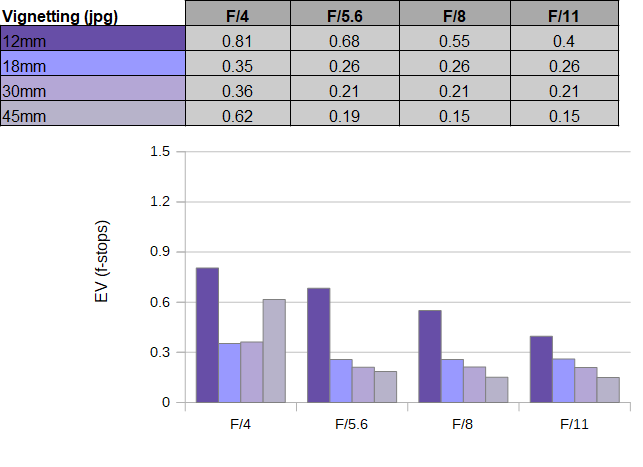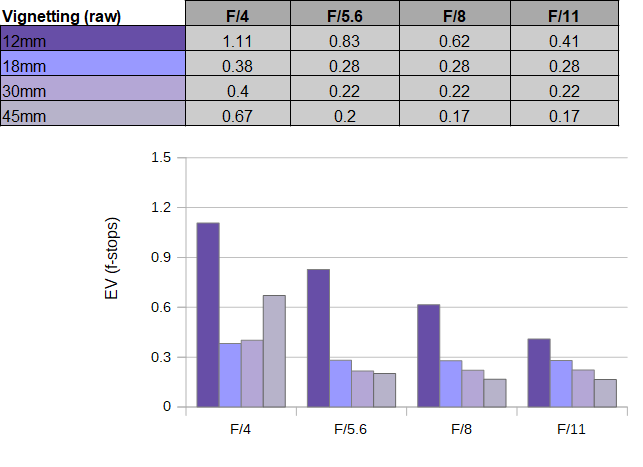|
Olympus M.Zuiko ED 12-45mm f/4 PRO - Review / Lens Test Report - Analysis |
|
Lens Reviews -
(Micro-)Four-Thirds
|
|
Page 2 of 3

Distortion
Micro-Four-Thirds cameras use an auto-correction mechanism for image distortions thus there isn't much to worry about in this respect. There is a trace of barrel distortion (1.1%) at 12mm but this is almost negligible.
You may argue that RAW distortions are irrelevant in the MFT scope but they can give a hint towards what can be expected in the MTF chapter.
At 12mm, there's a MASSIVE amount of barrel distortion (6.2%) which is, without correction, unusable by most standards. At 18mm, they are tamed down to a moderate level. At 30mm and 45mm, they swing to medium pincushion distortions - not great but not terrible either.
Vignetting
Vignetting is another aspect that is usually corrected under the hood. There's still some visible light falloff at 12mm and at 45mm f/4 but it doesn't reach disturbing levels.
 Image auto-correction doesn't have to be all that aggressive here. There is a relatively minor relative increase at 12mm and "large" aperture settings but this is about it. Or in other words - the lens isn't underdesigned in this respect (unlike some other lenses - I'm looking at you, Canon RF 24-105mm f/4-7.1 STM IS).
Image auto-correction doesn't have to be all that aggressive here. There is a relatively minor relative increase at 12mm and "large" aperture settings but this is about it. Or in other words - the lens isn't underdesigned in this respect (unlike some other lenses - I'm looking at you, Canon RF 24-105mm f/4-7.1 STM IS).

MTF (resolution)
In the scope of Micro-Four-Thirds, lenses tend to reach their peak performance between f/2 and f/2.8. Obviously, the Olympus M.Zuiko ED 12-45mm f/4 PRO is already slower than this and diffraction is the limiting factor even at f/4. Given the depth-of-field characteristic, it is therefore important to have the best possible performance without stopping down (much). The Olympus lens is (mostly) capable of providing this. The center quality is excellent throughout the zoom range at f/4 and f/5.6. The border "situation" is most interesting at 12mm, of course. Remember that we detected massive RAW distortions at this setting? The correction is taking its toll on the achievable resolution due to the required image stretching. At focal lengths with less aggressive distortion correction, the borders/corners are on a very good level. Diffraction becomes an issue from f/11 onward. If you are used to bigger formats, remember that f/8 on MFT is equivalent to f/16 (full format) so it's just not necessary to stop down that much in most scenes.
The centering quality of the tested sample was good. The field curvature is low at conventional focus distances.
Please note that the MTF results are not directly comparable across the different systems!
Below is a simplified summary of the formal findings. The chart shows line widths per picture height (LW/PH) which can be taken as a measure of sharpness.
If you want to know more about the MTF50 figures, you may check out the corresponding Imatest Explanations

Chromatic Aberrations (CAs)
Lateral CAs (color shadows at the image borders) are very low, with an average pixel width of less than ~0.5px. The CAs increase slightly when stopping down but they remain unobtrusive.

Bokeh
If you buy into the MFT system and especially this lens for achieving beautiful bokeh, you are doing it wrong. Achieving a shallow depth-of-field is, of course, not impossible but it's just not a strength. The sample image section contains some examples of what's possible in real life by choosing a fairly short focus distance at least.
Even so, let's have a brief look at two aspects. Out-of-focus highlights are circular in the image center but show both a fairly busy inner substructure and outlining. Stopping down shows the more edgy aperture shape already.
 Highlights are one thing, the smoothness in the focus transition zones is another one. We haven't tested this formally but the blur is quite pleasing as you can see below.
Highlights are one thing, the smoothness in the focus transition zones is another one. We haven't tested this formally but the blur is quite pleasing as you can see below.

|